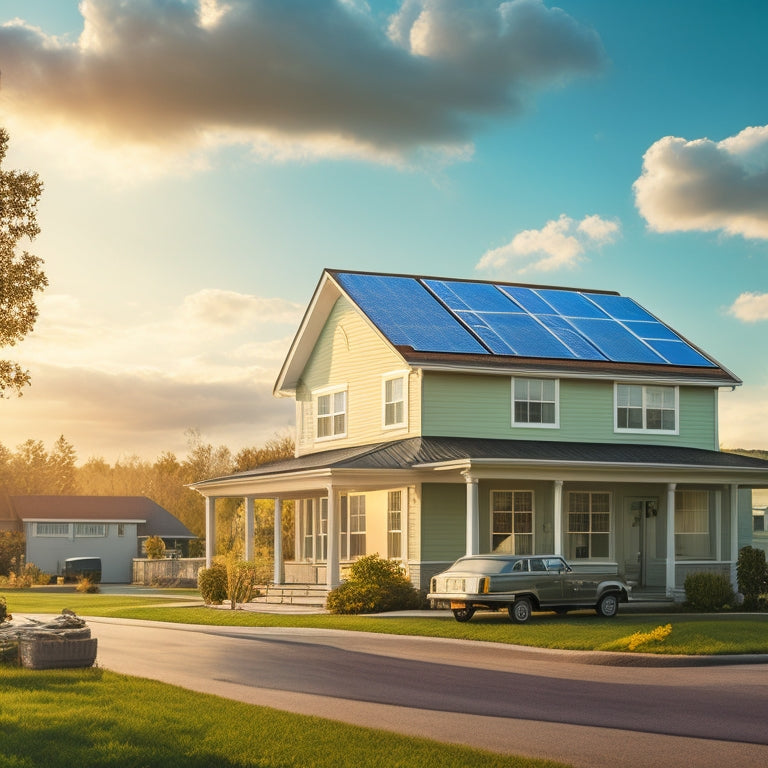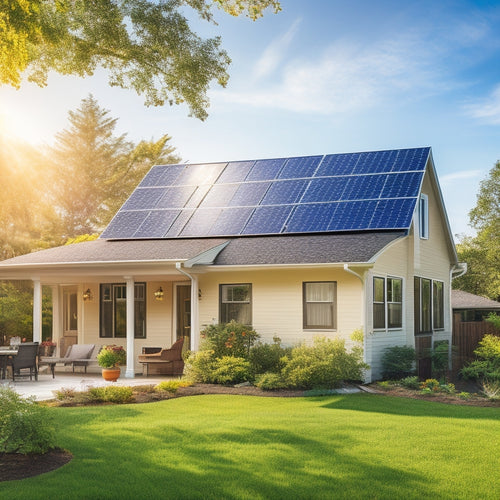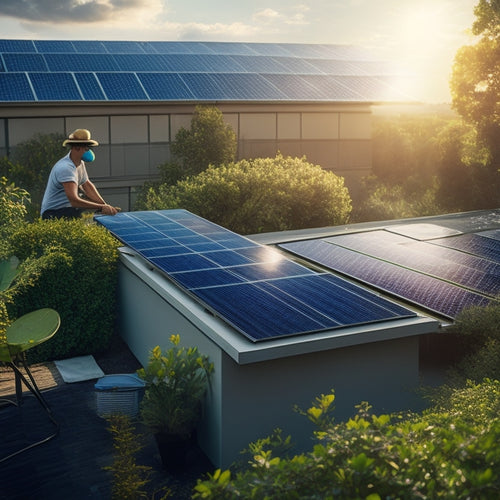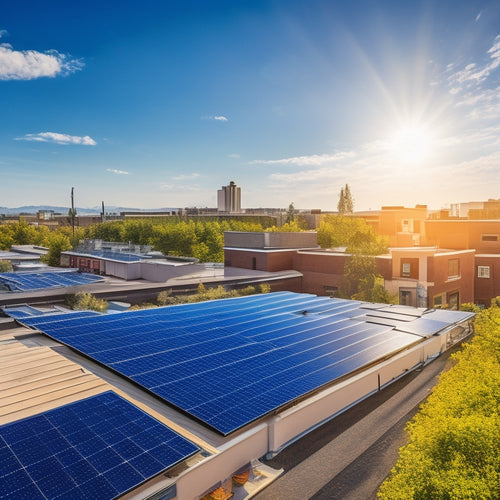
5 Key Factors Affecting Residential Solar Panel Costs
Share
Five key factors affecting residential solar panel costs include panel types, installation complexity, system size, available incentives, and energy storage options. Monocrystalline panels, while efficient, cost more than polycrystalline and thin-film types. Installation costs vary based on your roof condition, local regulations, and shading analysis. System size depends on your energy consumption, with larger systems costing more upfront but potentially generating surplus energy. Federal and state incentives, like the Investment Tax Credit, can significantly reduce costs. Lastly, investing in advanced energy storage systems like lithium-ion batteries can impact overall expenses. Explore further to grasp the full financial and technical landscape.
Key Takeaways
- Panel Type: Monocrystalline, polycrystalline, and thin-film panels vary in cost and efficiency, impacting overall system expense.
- Installation Complexity: Roof condition, structural reinforcements, and compliance with local regulations affect labor and material costs.
- System Size: Larger systems generally cost more due to the number of panels and additional equipment required.
- Incentives and Rebates: Federal and state incentives can significantly reduce the initial investment in solar panels.
- Energy Storage Solutions: Adding battery storage increases upfront costs but offers long-term savings and energy independence.
Solar Panel Types
https://www.youtube.com/watch?v=kP8KO1gWOjk
When evaluating solar panel types, you'll primarily encounter three options: monocrystalline, polycrystalline, and thin-film. Each type has its own characteristics that impact panel efficiency and material quality.
Monocrystalline panels, made from a single crystal structure, offer the highest efficiency rates, typically between 15-20%. Their high material quality guarantees longevity and superior performance, especially in limited space. This makes them ideal if you're aiming for maximum energy output per square foot.
Polycrystalline panels, on the other hand, are composed of multiple silicon crystals. Their efficiency ranges from 13-16%, slightly lower than monocrystalline panels. However, they offer a solid balance between cost and performance. The material quality is decent but not as high as monocrystalline, which can impact their overall effectiveness and lifespan.
Thin-film panels, constructed from a variety of materials like cadmium telluride or amorphous silicon, provide the lowest efficiency, often between 10-12%. Despite their lower efficiency and material quality, these panels are flexible and lightweight, making them versatile for unconventional installations.
Each option has trade-offs, but understanding these differences empowers you to make a choice that aligns with your energy needs and financial goals.
Installation Complexity
Understanding the installation complexity of residential solar panels requires a thorough grasp of several factors, including roof condition, panel type, and local regulations. Analyzing your roof's condition is pivotal; a structurally sound roof can save you from additional costs associated with repairs or reinforcements. If your roof is aging or damaged, you might need to invest in renovations, greatly impacting overall installation expenses.
Performing a shading analysis is equally important. You need to assess how shadows from trees, buildings, or other obstructions affect sunlight exposure on your roof. Limited sunlight can reduce your solar panel efficiency, requiring more panels or specialized equipment to meet your energy needs. Modern shading analysis tools provide precise data, helping you optimize panel placement and minimize inefficiencies.
Local regulations and permitting processes can also complicate installation. Compliance with zoning laws, building codes, and utility interconnection standards often necessitates detailed documentation and inspections, which can delay installation and increase costs. Each municipality has its own set of rules, so understanding these requirements helps you avoid unexpected hurdles.
System Size
Determining the best system size for your residential solar panels hinges on accurately evaluating your energy consumption patterns and future energy needs. A thorough analysis of your monthly and yearly electricity usage will provide a baseline for sizing your system. Start by examining past utility bills to understand your average kilowatt-hour (kWh) consumption.
Next, consider any anticipated changes in your energy consumption. Are you planning to purchase an electric vehicle, or install energy-intensive appliances? These factors will influence the required capacity of your solar system.
Roof space is another critical element. The physical dimensions of your roof will either constrain or enable your ability to install the necessary number of panels. Calculate the usable roof area by accounting for obstructions like chimneys, skylights, and vents. Efficiently using your available roof space can maximize energy production and economic benefits.
Lastly, balance your energy goals with system size. A larger system can generate surplus energy, potentially leading to credits from your utility company, while a smaller system may primarily offset a portion of your consumption. Tailoring your system size ensures you achieve the best efficiency and cost-effectiveness, liberating yourself from escalating energy costs.
Incentives and Rebates
Take advantage of various incentives and rebates available to greatly reduce the upfront costs of installing residential solar panels. Federal incentives, especially the Investment Tax Credit (ITC), allow you to deduct a significant portion of your solar installation costs directly from your federal taxes. As of 2023, the ITC covers 26% of your system's cost, translating into substantial savings. However, this percentage is set to decrease in the coming years, so acting now maximizes your benefits.
State rebates further amplify these savings. Many states offer direct cash rebates or performance-based incentives, reducing your effective out-of-pocket expenditure. For instance, California's Self-Generation Incentive Program (SGIP) provides substantial rebates for battery storage systems paired with solar, though specific rebates vary by state and utility.
Analyzing these incentives and rebates together, you can strategically lower your financial burden. Combining federal incentives with state rebates often results in a quicker payback period and increased long-term savings.
Research your local programs meticulously; some regions offer additional perks like property tax exemptions or sales tax deductions. By leveraging these financial tools, you not only cut costs, but also accelerate your journey towards energy independence and environmental stewardship.
Energy Storage Options
To maximize the benefits of your solar installation and further reduce costs, consider integrating advanced energy storage options to guarantee a reliable and efficient power supply. By doing so, you can enhance your energy independence and optimize the utilization of generated solar power, especially during peak demand periods or outages.
When selecting a storage solution, focus on battery lifespan and storage capacity. Lithium-ion batteries, for instance, offer high energy density, long cycle life, and superior efficiency. Their typical lifespan ranges from 10 to 15 years, making them a robust investment.
On the other hand, flow batteries, while having lower energy density, provide virtually unlimited cycling and longer operational life, which can translate into lower long-term costs.
Analyze your household's energy consumption patterns to determine the required storage capacity. A higher capacity ensures you can store excess energy generated during sunny periods and use it during nighttime or cloudy days. This not only reduces reliance on grid power but also protects you from fluctuating electricity rates.
Frequently Asked Questions
How Do Local Climate Conditions Affect Solar Panel Efficiency and Costs?
Local climate conditions impact solar panel efficiency and costs. Sunlight exposure determines energy output, while temperature fluctuations affect performance. Analyze your area's sunlight data and temperature trends to optimize efficiency and minimize expenses for true energy liberation.
What Is the Average Lifespan of Residential Solar Panels?
The average lifespan of residential solar panels is around 25-30 years. You'll see a degradation rate of about 0.5-1% per year, with most warranty periods covering 20-25 years, ensuring long-term efficiency and reliability.
How Do Maintenance Costs Impact the Overall Expense of a Solar Panel System?
Think of maintenance costs as the heartbeat of your solar panel system's expenses. Cleaning frequency and warranty coverage notably affect overall costs. Regular cleaning boosts efficiency, while extended warranty coverage mitigates potential repair expenses.
Are There Financing Options Available for Residential Solar Panel Installations?
Absolutely, you can access various financing options for residential solar panel installations. Government incentives and loan programs make it easier to invest, reducing upfront costs and ensuring you gain energy independence while saving money long-term.
How Do Electricity Rates Influence the Return on Investment for Solar Panels?
Electricity rates directly impact your solar panel ROI. Higher electricity demand and rates accelerate achieving grid parity, making your investment more lucrative. Analyze local rates and consumption patterns to maximize savings and gain energy independence.
Related Posts
-

How to Finance Home Solar Panels
Financing home solar panels offers several strategies to lighten your initial costs while maximizing long-term benefi...
-

Green Ways to Maintain Solar Panels
To maintain your solar panels sustainably, start with regular inspections to catch potential issues early, enhancing ...
-

Solar Energy Solutions for Small Businesses
Switching to solar energy can be a game changer for your small business. You'll enjoy significant cost savings on mon...


